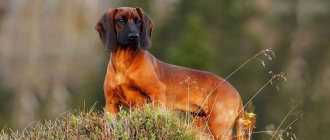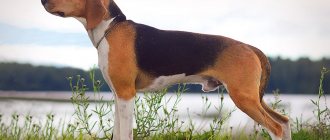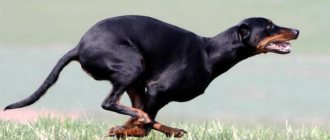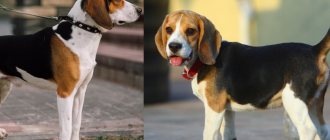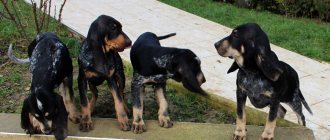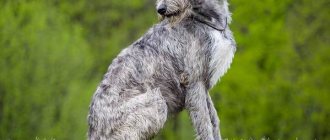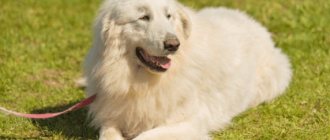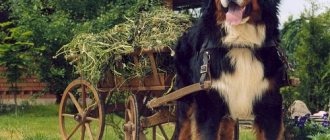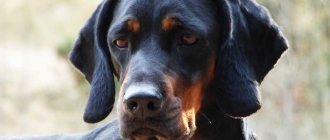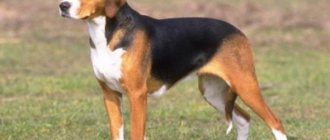The breed of large and hardy hunting dogs appeared at the beginning of the 19th century in the vicinity of the Bavarian mountain range. Today, the Bavarian mountain hound is a rare breed that has fully retained its working qualities. In addition to hunting, these dogs are used to search for climbers and skiers who have disappeared in the mountains. The Bavarian hound has a phenomenal flair - the ability to accurately follow an already cold trail, which is extremely highly valued in rescue and search work.
Breed description, standards, appearance
The Bavarian Mountain Hound is a harmoniously built dog with a moderately elongated body and well-developed muscles. According to the international classification, the breed is classified in group 6 “Hounds and related breeds”, section 2 “Hounds by blood trail” with testing of working skills.
Size and constitution
The Bavarian Mountain Hound is a medium-sized dog with moderate sexual dimorphism. The height of the female is 44-48 cm, the male is 47-52 cm at the withers.
According to FCI standard No. 217, a typical Bavarian Mountain Hound must meet the following description:
- The head is proportional with a relatively wide, slightly convex skull, pronounced stop, developed eyebrows and occipital protuberance. The muzzle is blunt, short, moderately full under the eyes. Nose with a straight or slightly convex back, large black, brown or dark red lobe and well-opened nostrils. The jaws are strong, covered with well-fitting, moderately thick lips. The teeth are strong, healthy, fully equipped. Scissor bite or straight bite.
- The eyes are not too large with close-fitting, well-pigmented eyelids and brown irises. An attentive look.
- The ears are elongated, heavy, set high with a wide base and rounded tips. Hangs down the sides of the head without curling.
- The body is moderately elongated with a strong neck, slightly pronounced withers, a strong, flexible back, a long, slightly sloping croup and a wide, short, muscular loin. The chest is quite wide, deep, oval in cross-section with the ribs well laid back. The stomach is slightly tucked.
- The limbs are straight, parallel with good angulations, oval paws, arched toes, strong, rough pads and strong nails of black or horn color. The movements are sweeping, springy with a powerful push of the hind legs and a good reach of the front legs.
- The tail is of medium length, set high. When moving, it carries horizontally or drops slightly downwards.
Serious deficiencies that would prevent the Bavarian Mountain Hound from receiving the maximum expert rating include:
- damp eyelids;
- elbows turned outward or inward;
- close-knit or barrel-shaped hind legs;
- flesh-colored nose;
- slight over/undershot;
- hunchback/sagging back;
- straightened angles of the hind limbs;
- barrel or flat chest.
The defects that will disqualify the Bavarian Mountain Hound include:
- significant malocclusion (overbite/underbite);
- jaw distortion;
- lack of teeth (except P1);
- creases on the tail;
- entropy/ectropy;
- cryptorchidism (in males).
Color and coat type
The Bavarian Mountain Hound is covered with thick, smooth, moderately coarse hair that lies close to the body. On the tail, belly and limbs the hair is slightly longer and coarser. The head and ears of the Bavarian are covered with ultra-short, fine hair.
According to the breed standard, several color options are allowed, including:
- brown (chestnut);
- reindeer (biscuit);
- red-gray;
- reddish brown;
- deer red;
- brindle;
- Dark red.
Darker hair grows on the back and ears of the Bavarian, and there is a blackened mask on the face. A small light spot on the dog's chest is acceptable. The tail is dark or interspersed with dark hairs.
Description of the Bavarian Mountain Hound breed
Bayerischer gebirgsshweisshund is a Bavarian bloodhound, this is how the name of this breed is literally translated from German. These dogs are used only for hunting. A distinctive feature of the Bavarian Bloodhound is its very acute sense of smell; it can navigate solely by the smell of the animal. They can pick up a very old scent and will not lose it even if the animal moves to the other side of the pond, they also work well in bad weather. The dog confidently follows the scent, accompanying the search with his voice, and does not lose sight of the owner.
Bavarian stallion designed for hunting
Bavarians can successfully participate in literally all canine competitions (coursing, agility, freestyle, etc.), are used in public service (police, customs) and are used in search and rescue operations.
Appearance
The body of the Bavarian Hound is strong, slightly stocky, balanced and harmonious, with a powerful frame and a well-developed muscle belt. The body is elongated, with a slender, strong back, light withers, an elongated, slightly sloping croup, a deep, moderately wide, oval chest, a strong, short loin and a slightly tucked belly. This is a medium-sized dog, light and extremely agile.
Bavarians have a muscular and somewhat stocky build.
Pedigree standard:
- Height at withers: Females - 44-48 cm;
- Men 47-52 cm.
The Bavarian moves lightly, springily and far apart, pushing off powerfully with his hind legs and swinging his front legs freely. The gait is flexible and slightly springy.
The Bavarian moves flexibly and expansively.
The coat is shiny and smooth, short and dense, rough to the touch, without undercoat. On the belly, tail and legs the hair is slightly longer and coarser, while on the ears and the entire head it is thinner and noticeably shorter. The skin is dense and thick.
The standard allows only shades of red (reddish) and brown in color:
- reddish brown;
- Dark red;
- deer (biscuit);
- brownish (chestnut);
- reddish-gray;
- red deer;
- tiger (rare).
A dark mask on the face is required. The ears are noticeably darker than the overall shade of the coat, which is also more intense on the back. The tail is often completely dark or spotted. A small lightened spot on the chest (called a “bracket star”) is acceptable (but not encouraged).
All shades of red are allowed, with a mandatory dark mask on the face.
Disadvantages and disqualifying vices
Minor deviations from the characteristics of the breed are considered defects or shortcomings, the severity of which is assessed by the degree to which they appear, and by their effect on the health, welfare and well-being of the animal.
Serious defects may be:
- Minor problems with the jaw apparatus (valgus, underdevelopment, etc.);
- The nose is not dark in color (beige, pink, etc.);
- wet, loose eyelids;
- higher or shorter than acceptable;
- Flat or barrel chest;
- an arched (hunchbacked) or sagging (sagging) back;
- incorrect position of the limbs;
- elbows on legs turned outward or inward;
- the coat is thin or scanty;
- black spotted color.
A dog with the following defects shall be disqualified:
- bent or broken tail;
- Very pronounced malocclusion;
- absence of teeth (except for first molars);
- Weakness, lethargic temperament;
- Excessive cowardice or aggression;
- Curled or permanently drooping eyelids.
Character and psyche of the breed
The Highlander has a balanced, calm and quiet temperament. During the hunt, it turns into an active, passionate and persistent hunting dog, completely concentrating on finding prey. The strong hunting instinct makes it impossible to keep these dogs with other pets (especially small ones), since Bavarians see them only as potential prey, and not as playmates. They love children, but prefer not to come into close contact with them and keep a low profile.
A well-mannered Bavarian gets along well with other dogs.
They get along less well with other dogs than most mating dogs because they work alone on the trail while others work in a pack. This breed needs to be socialized as early as possible to avoid conflicts and fights. They treat strangers with suspicion and mistrust, but never aggressively. For this reason, the Bavarian stallion will never make a good guard dog.
She is very attached to her family, but gives priority to her hunter master and obeys him almost unconditionally. Left alone, the dog begins to feel sad and bored, as it is very human-oriented and needs company.
Unlike many hunting dogs, buffaloes never run away from their owners. They always try to look after him and return to him regularly.
Our dog Drathaar initially created a lot of problems because, succumbing to the excitement of the hunt, she did not obey commands and ran very far away. Sometimes we had to search for him for several hours. Then she wised up, matured and no longer committed such rash acts.
Character and behavior
The Bavarian Mountain Hound has a balanced psyche and calm temperament. In everyday life, the dog behaves quietly. But, once in the field, the Bavarian transforms into an assertive, passionate hunter, completely focused on finding prey.
The dog easily finds a common language with all members of the household, but distinguishes one owner among them. The Bavarian Mountain Hound needs constant contact with people and does not tolerate loneliness well. Deprived of communication, the dog begins to feel sad and may get sick.
On a note. Unlike representatives of other hunting breeds, the Bavarian mountain hound never runs far from its owner. The dog tries not to lose sight of him and periodically returns to him.
The Bavarian is wary of strangers, but non-aggressive. Therefore, she is not suitable for the role of a security guard.
Breed and children
The Bavarian Mountain Hound is loyal to children and never offends them. At the same time, the dog tries to avoid close contact with babies and prefers to stay away.
Breed and other animals
The Bavarian Mountain Hound has developed hunting instincts and views other pets as potential prey. Therefore, it is better not to keep the dog together with other animals, especially small ones.
Unlike representatives of most hunting breeds, the Bavarian is used to working alone. Therefore, she rarely develops friendly relationships with other dogs.
Brief history of origin
The Bavarian Mountain Hound is a relatively young breed, whose homeland is considered to be Germany. It was bred in the 70s of the 19th century and descends from the Hanoverian hounds.
The ancestors of the Bavarian were large, massive dogs and specialized in working on the blood trail and catching wounded animals. Heavy and bulky Hanoverian hounds turned out to be unsuitable for hunting in difficult mountainous landscapes. The clumsy animals often fell off cliffs and steep mountain paths.
To rectify the situation, experts decided to dilute the blood of Hanoverian hounds with the genes of compact and agile Tyrolean hounds and local hunting dogs, which the inhabitants of Germany called Bracks. It is possible that representatives of other varieties also took part in the formation of the breed. But no documents confirming this have been found.
The Bavarian Mountain Hound received its first standard in 1883. And the only official club of breed lovers, whose headquarters is in Munich, appeared in 1912.
The organization is engaged in breeding activities, regulates the work of breeders and monitors all litters that appear. The Bavarian Mountain Hound received recognition from the Fédération Cynologique Internationale in 1959.
Brief historical background
The Ogar does not have a long history, and the Highlander is considered a relatively young breed, having only appeared in the 1870s. It was developed from the Hanoverian dog, a large and massive dog that only worked on blood trails and boulder grabs. The large animal was not suitable for searching for a stallion in difficult mountainous terrain, as it was rather clumsy and clumsy. There have even been accidents where dogs have fallen from steep mountain paths and cliffs.
The Hanoverian stallion turned out to be too large and clumsy for hunting in the mountains.
The Hanoverian Hound needed a lighter, faster and more agile dog, so it was made lighter by adding blood from the agile, fast and small Tyrolean dogs, as well as local hunting dogs, which the Germans call Brekker. It is possible that other dogs were also used for mating, but no records of this survive. The Bavarian stallion was officially recognized as a new breed (Hannoversche Schweißhund) by the then Kennel Society in 1883, around the same time the first breed standard was developed.
The only recognized and official Bavarian Schweishound club that still exists today is the Club of Bavarian Gebirgschweishunds (KBGS), which was founded in 1912 and is based in Munich. This organization conducts breeding work, carefully controls all breeding, inspects breeders and issues permits for the distribution of puppies only to professional foresters, rangers and hunters. All this is done to ensure that the dogs continue to work in accordance with their specialization and do not lose their unique characteristics.
In 1959, the Bavarian stallion was registered with the FCI and classified in section 6 (Bloodhound and related breeds). The latest current breed standard is dated September 16, 1996.
Interesting Facts
Despite the relative youth of the breed, a lot of interesting things can be said about the Bavarian mountain hound:
- The German name of the breed Bayerischer gebirgsshweisshund literally translated into Russian means “Bavarian blood-trace hound.”
- The dog has a phenomenal sense of smell and when hunting is guided solely by the smell of the animal. The Bavarian can work in bad weather and easily picks up the old trail, without losing it even if the fugitive has moved to the other side of the reservoir.
Care and maintenance
The ideal place to keep a Bavarian mountain hound is a spacious, securely fenced yard of a private cottage, where an indoor enclosure with a spacious booth is equipped for it. But due to its short fur, the dog does not tolerate low temperatures well and with the onset of cold weather it needs to be moved indoors.
On a note. If necessary, the Bavarian Mountain Hound can adapt to apartment life. But then she will need regular physical activity.
Hygiene procedures
The short coat of the Bavarian does not require special grooming. In order for the dog to have a well-groomed appearance, it is treated 1-2 times a week with a special brush or rubber glove.
During molting, which occurs in the off-season, the bavka is combed daily. This simple procedure will help speed up the process of hair loss and activate blood circulation.
Bavarian mountain hounds are bathed using gentle pet shampoos for short-haired breeds approximately once a quarter. More frequent washing dries out the dog's skin and leads to the development of dermatological diseases.
On a note. The Bavarian Mountain Hound often suffers from blood-sucking parasites. Therefore, from early spring to late autumn, the dog is regularly treated for fleas and ticks using drops, sprays or tablets.
In the floppy ears of a Bavarian dog, air does not circulate well enough and dirt quickly accumulates. To prevent otitis media, they are cleaned weekly with cotton pads moistened with chlorhexidine, hydrogen peroxide or a special lotion.
If redness, copious or unpleasant-smelling discharge is detected, the dog is taken to a veterinarian.
The Bavarian woman's eyes are wiped every morning with clean napkins moistened with chamomile infusion, unsweetened strong tea or settled boiled water.
If increased lacrimation or purulent discharge is detected, the dog should be shown to a specialist so as not to miss the onset of allergies and other serious pathologies.
The Bavarian Mountain Hound's claws usually wear down during walks. If they grow faster and prevent the dog from walking normally, they are carefully shortened with a nail clipper.
Feeding
Energetic and efficient, Bavarian mountain hounds require a high-calorie diet containing sufficient amounts of protein. Many hunters traditionally prefer to feed these dogs natural products.
With this type of nutrition, the diet of Bavarian mountain hounds should consist of at least 2/3 of raw, sinewy meat, kept for at least three days in the freezer and scalded with boiling water. It can be lean lamb, beef, horse meat or veal.
Twice a week, meat feeding should be replaced with offal, such as tripe, lungs, heart, liver or kidneys.
Also in the diet of Bavarian mountain hounds should appear:
- eggs;
- vegetables;
- cereals;
- sour milk.
During the period of active growth and change of teeth, it is recommended to give the Bavarian woman calcium supplements. And in the off-season, vitamin-mineral complexes are recommended for the dog.
Important! Bavarians need a balanced but monotonous diet. Therefore, dogs’ diet should not contain river bony fish, sweets, sausages, fatty meat, mushrooms, pickles, marinades, seasonings, exotic fruits and any leftovers from the owner’s plate.
So that preparing food for your pet does not take up all your free time, the Bavarian mountain hound can be switched to dry food. Ideally, these should be imported premium or super premium products, like Orijen, Acana, Farmina or Belcando.
Walking and exercise
The Bavarian Mountain Hound is a hardy and agile dog that needs systematic exercise. To maintain muscle tone and prevent physical inactivity, you need to be outside with her twice a day for at least 1.5-2 hours.
In the warm season, it is recommended to exercise the Bavarian by swimming. During the season, you can go hunting for ungulates with your dog or take part in a driven hunt for a hare or duck. The rest of the time, it is advisable to engage in coursing, agility, freestyle or Frisbee with the Bavarian Mountain Hound.
Training and education
The Bavarian Mountain Hound is an intellectually developed dog that easily makes contact with humans. She is quite trainable and quickly understands what is expected of her. The Bavarian woman is clearly aware of the limits of what is permitted, but periodically tests the owner’s strength.
On a note. The Bavarian woman is fluent in acting and has a reputation as a manipulator. Therefore, when working with it, you need to adhere to the principle of consistency and be able to show persistence.
If you plan to go hunting with your Bavarian dog, she needs additional training. Puppy training begins at about 1.5-2 months. In the first stages he is introduced to paws, skins and hooves. From about 4 months of age, the puppy begins to be trained to follow a trail laid along a black trail.
At 9-10 months you can go to hunting grounds with your Bavarian dog.
Puberty and mating
The Bavarian Mountain Hound reaches sexual maturity at 7-9 months, but early pregnancy is fraught with health problems and often ends in the birth of weak or sick puppies. Therefore, it is recommended to untie the dog no earlier than 2 years.
By this moment, the Bavarian has time to fully form and can already bear and feed viable offspring.
Only mentally and physically healthy dogs under 8 years of age with good pedigree and standard appearance are allowed to breed. Mating is carried out 10-13 days from the start of estrus and repeated 24-48 hours later. It is advisable to schedule mating in the morning and on the male’s territory.
Bavarian mountain hounds bear offspring for about two months and give birth to 4-7 puppies.
Caring for puppies
A Bavarian Mountain Hound puppy is handed over to new owners no earlier than it is 8-9 weeks old. Therefore, future owners will easily have time to prepare everything necessary to care for their pet, including:
- a bed with replaceable mattress covers;
- bowls for water and food;
- several different toys;
- walking equipment;
- hygienic cosmetics;
- disposable diapers;
- grooming tools.
The place of the Bavarian puppy is determined to be away from drafts and heating appliances. To prevent an energetic and inquisitive baby from getting into trouble, detergents, electrical wires, medicines and easily breakable items are removed from the home in advance.
To protect the Bavarian from viruses and infections, until she receives all vaccinations and completes quarantine, she is kept in the house and not allowed near other animals.
Caring for the Bavarian Hound
Breeding Bavarian Gentian dogs is not at all difficult. Care is as follows:
- Short coats are brushed approximately once every 5-7 days (daily during shedding) to remove dead hair using a rubber brushing glove.
- Short-haired dogs should be bathed with shampoo at least once every 4-6 months.
- Nails are trimmed every 3-4 weeks unless they shave themselves.
- Brush your teeth at least once a week.
- The eyes are examined every 3-4 days and wiped with special wet wipes or cotton wool dipped in herbal teas (tea infusions are allowed).
- The ears are regularly ventilated and cleaned (at least once a month) with veterinary fluid or pharmaoxidine.
Real hunters prefer to feed their puppies homemade, freshly prepared food. For natural nutrition use:
- lean meat (horse meat, veal, etc.);
- Guts and offal (cartilage, trimmings, liver, kidneys, etc.)
- porridge (oatmeal, wheat, etc.)
- eggs
- sea fish; - boiled and raw vegetables
- Cooked and raw vegetables (pumpkin, zucchini, carrots, etc.)
- Greens, fruits (pears, apples);
- Vegetable oil (unrefined);
- Cheese, kefir, sour cream and other low-fat dairy products;
- Vitamin and mineral supplements.
Do not give your mountain dog bread, sweets, canned food, pasta, spicy, smoked or hot food.
Some owners keep their pets on freeze-dried food and choose super premium dry food (Acana, Proplan, etc.). Adult dogs are fed twice a day, puppies need more frequent feeding (3-6 times).
Ideally, a Bavarian dog should be kept in a private home with a large yard or large area with a well-insulated kennel. However, the dog should not be kept there all year round, but should live in a heated room during the cold season. The Bavarian will adapt to apartment life, but needs sufficient exercise during long walks along paths or in the forest.
The Bavarian Ogar needs long walks and good physical activity.
This specific hunting dog is best suited for a professional forester or game warden, an avid hunter, or a person with an active lifestyle. It is not very suitable as a pet.
Training
Like all hounds, Bavarians are very provocative and prone to independence, so they need to be trained very early (from 2-2.5 months) and taught simple commands. His owner must have a strong character and a firm hand for the puppy to recognize him as an absolute leader. Immediate training should be handled by a professional trainer who has experience working with difficult dogs. It is recommended to take an obedience course after the puppy is six months old.
At the age of 4-5 months, the puppy is taken out into the field and begins to be taught to work on the scent; at the age of 9-10 months, the dog is taken out into the field so that it can hunt properly.
Learning to use hunting equipment and training puppies begins very early.
How to choose a pet
The Bavarian Mountain Hound is a rare breed whose puppies are preferred to be sold to hunters. The average cost of a purebred dog varies between 40-70 thousand rubles and depends on the prospects of the individual.
In order not to make a mistake when choosing a puppy, before purchasing a Bavarian you should pay attention to:
- availability of documents;
- health status;
- character traits;
- compliance with the breed standard;
- living conditions for mother and offspring.
A healthy Bavarian Mountain Hound puppy should have straight paws, a soft belly, smooth, short fur, a pedigree head, a characteristic color, a well-fed body, clean eyes and ears. It is important that the baby does not sit huddled in a corner, but is actively interested in what is happening.
Choosing and purchasing a puppy
In Russia, the breed is represented by only a few dozen dogs. It is better to buy a puppy in the homeland of the hound, choosing one of the German nurseries. A potential dog owner will have to prove that he is a hunter and has all the conditions for keeping and working with a pet. In Russia there are such nurseries specializing in breeding Bavarians: Goddeshunt, Bird's Nest. In our country there is a club for dog lovers - Chronicles of the Bavarian Hound. Owners of Bavarians exchange tips on raising and maintaining pets. Organize joint trainings. The price for a Bavarian hound starts at $2,000. But even despite such a considerable cost, there is always a queue for puppies.
How to choose a puppy
From the litter you should take the most curious and courageous baby, the one who is the first to sniff a stranger. You should also pay attention to the condition of the coat, skin, eyes, ears, and teeth.
The presence of documents and a medical certificate is mandatory.
Nicknames
In the name of a hunting dog, it is customary to emphasize the working qualities of the animal and its character traits. For example: Fast, Thunder, Bass, Alarm, Mischievous, Hurricane, Guy, Roll, Roll, Excitement, Courage, Flurry. The following nicknames are suitable for bitches: Aika, Venus, Volna, Vyuga, Gaida, Zabava, Zvezda, Zapevka, Rocket, Purga, Taiga, Yula, Zven, Passion. Some owners focus on the German origin of the dog, giving the following names: Hans, Elba, Alpa, Gertrude, Gerda, Berg.
The Bavarian mountain dog is a subtle and precise assistant to a person not only in hunting, but also in searching for people missing in the mountains. Only careful treatment of the breed and preservation of its working qualities will help preserve these wonderful animals for descendants.
Pros and cons of the breed
The Bavarian Mountain Hound is a highly specialized breed with its own advantages and disadvantages.
| pros | Minuses |
| Pronounced hunting instincts | Load requirement |
| Lack of aggression towards people | Stubbornness |
| Stable psyche | Rarity of the breed |
The Bavarian Mountain Hound is a specific breed with pronounced hunting qualities and a rather stubborn character. She is not suitable for the role of a couch dog and will become a real find for professional huntsmen and foresters.
Description of the breed
The animal has an elongated rectangular body. The general appearance of the dog - strong muscles, heavy bones, short and strong legs - speaks of the strength of the animal. The head is elongated, the forehead is high. The ears are set high, small, hanging. Eyes brown or black. The jaws are powerful. The tail is saber-shaped, its length just below the hock joint. The Bavarian's coat is short, almost without undercoat, close to the body, and hard. Colors: fawn, brindle, red. White markings on the chest are allowed. Dimensions of the animal: height at the withers of an adult cable reaches 54 cm, females - 50 cm. Weight ranges between 25-27 kg.
Character
A distinctive feature of the Bavarian mountain hound is that it does not pursue prey by seeing or hearing it, but follows the scent. Rain and wind do not prevent the dog from accurately following the subtle scent of a wounded animal.
The dog is devoted to its owner, its main goal and purpose in life is to hunt under the guidance of its person. Unable to track down game, the hound, locked alone in an apartment, suffers and becomes depressed. This is one of the reasons why Bavarian huntress puppies are not sold to ordinary people. Representatives of the breed are friendly to people, but their strong prey instinct excludes them from being together with other animals.
